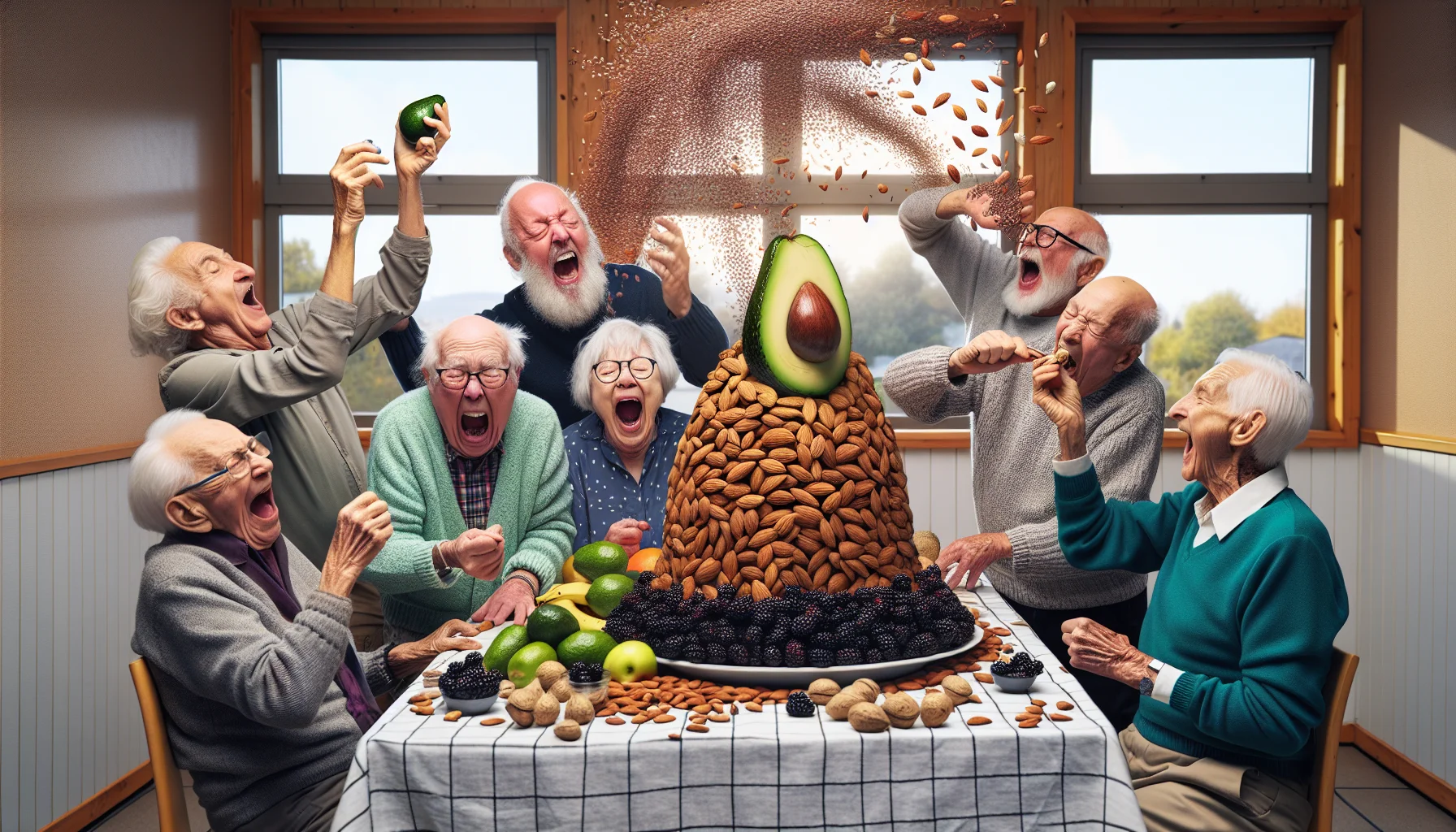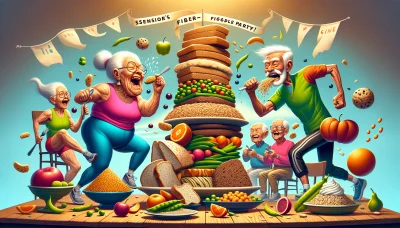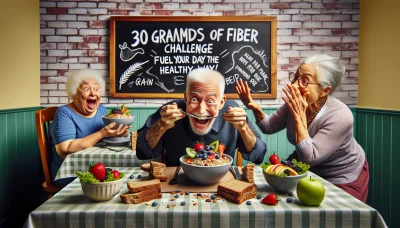What foods are high fiber low carb Quiz
Test Your Knowledge
Question of
Understanding High Fiber, Low Carb Foods
Definition and Health Benefits
What Are High Fiber, Low Carb Foods? These are nutrient-dense foods that pack a lot of fiber while keeping the carbohydrate count low. They're an exceptional choice for maintaining blood sugar levels and supporting a healthy digestive system. Think leafy greens, nuts, and seeds these are your powerhouses!
Why Incorporate Them Into Your Diet? Integrating high fiber, low carb foods into your diet can be transformative! They help you feel full longer, control appetite, and may assist in weight management. Not to mention, they're fantastic for your gut health. This isn't just a trend; it's a lifestyle change with profound benefits.
Long-Term Health Advantages The long-term health benefits of these foods are undeniable. Regular consumption can lead to reduced risks of chronic diseases such as type 2 diabetes, heart disease, and certain cancers. It's not just about the present; it's about securing a healthier future for yourself!
Macronutrients Breakdown
Role of Fiber in Digestion Fiber is a superstar when it comes to digestion! It aids in slowing down food absorption, which ensures that your blood sugar levels remain stable. Plus, it supports bowel regularity and helps prevent constipation. It's an unsung hero in the world of macronutrients.
Impact of Low Carb on Metabolism Lowering your carb intake has a direct impact on your metabolism. It encourages your body to burn fat for energy instead of relying on carbs. This metabolic switch can lead to improved insulin sensitivity and even spur weight loss. It's like hitting the reset button on your body's energy usage!
Balancing Proteins and Fats While focusing on fiber and lowering carbs, don't forget about proteins and fatsthey're essential too! They work together to keep you satiated and provide sustained energy throughout the day. Balance is key; it's all about finding harmony among these macronutrients.
Identifying High Fiber, Low Carb Foods
- Tips for Reading Nutrition Labels: - Always check the serving size firstit sets the stage for understanding everything else. - Focus on the 'Total Carbohydrates' and deduct the 'Dietary Fiber' to calculate net carbs. - Don't be fooled by 'sugar alcohols' some can affect blood sugar levels. - Look beyond carbs; pay attention to protein and fat content for overall balance.
- Mistakes to Avoid When Estimating Portion Sizes: - Skipping measuring tools: Eyeballing portions can lead to underestimating calorie intake. - Ignoring the impact of cooking: Remember that cooked food typically reduces in volume but not calorie content. - Forgetting about condiments: They can add significant carbs and calories.
- Using Food Lists and Apps: - Utilize dedicated apps that categorize high fiber, low carb foods for ease of reference. - Keep printed lists handy in your kitchen or wallet for quick grocery shopping decisions. - Regularly update your knowledge as new foods or products enter the market.
Incorporating High Fiber Foods into a Low Carb Diet
Meal Planning Strategies
Embarking on a low carb diet doesn't mean you have to sacrifice fiber. A strategic approach to meal planning can ensure you get the right balance of nutrients. Start by identifying high fiber, low carb foods that can form the basis of your meals. Think leafy greens, avocados, and flaxseeds. It's all about making informed choices!
Creating balanced meal plans revolves around variety and moderation. Incorporate a range of high fiber vegetables like broccoli and brussels sprouts with lean proteins and healthy fats. Balance is keyaim for a colorful plate at every meal to maximize nutrient intake without overloading on carbs.
Prepping meals for the week is a game-changer when it comes to staying on track. Dedicate time to batch-cook dishes that align with your dietary goals. By having ready-to-eat, nutritious meals on hand, you'll be less tempted to reach for carb-heavy alternatives when hunger strikes.
Timing your meals for optimal benefits involves understanding your body's needs throughout the day. A hearty breakfast packed with fiber can jumpstart your metabolism, while a light, early dinner may support better digestion and sleep patterns. Listen to your body's cues and adjust accordingly!
Recipes and Cooking Tips
Kickstart your day with high fiber, low carb breakfast ideas that energize without the carb crash. A spinach and cheddar omelet or Greek yogurt topped with chia seeds can provide a satiating start while keeping carbs in check. Breakfast sets the tone for the daymake it count!
Lunch and dinner recipes should include a balance of protein, fiber, and healthy fats. Consider grilled salmon with asparagus or a kale salad with roasted chicken and almonds. These combinations offer satisfying flavors while adhering to low carb guidelines.
- Snacks: Opt for celery sticks with almond butter or a small portion of mixed nuts.
- Desserts: Savor treats like dark chocolate or berries with whipped cream in moderation.
- Hydration: Drink plenty of water throughout the day to aid digestion and feel full.
- Fiber Boost: Add psyllium husk powder to shakes or smoothies for an extra fiber kick.
- Variety: Rotate your snacks and desserts to prevent boredom and maintain nutritional balance.
Snacks and desserts that fit the bill are crucial for curbing cravings without derailing your diet goals. Look for options that are both delicious and nourishingthink avocado chocolate mousse or homemade kale chips.
Eating Out and Social Events
Choosing the right restaurants is essential when maintaining a high fiber, low carb diet. Research menus ahead of time to find places that offer suitable options such as salads with protein or grilled vegetable dishes. Don't be shy about asking for customizations!
Navigating menus for better choices involves skillful decision-making. Opt for dishes that are rich in vegetables and lean proteins while avoiding breaded or fried items. Always inquire about dressings and saucesthey can be hidden sources of carbs!
Handling social gatherings with ease is all about preparation and confidence in your dietary choices. Offer to bring a dish that fits within your diet parameters so theres something you can enjoy guilt-free. Communicate your dietary needs clearly but politely, focusing on the enjoyment of companionship rather than food restrictions.
Top High Fiber, Low Carb Foods to Include in Your Diet
Vegetables and Greens
Vegetables are the cornerstone of a nutritious diet, especially when you're aiming to balance fiber intake with low carbs. Including a variety of vegetables can ensure you're getting ample nutrients without overloading on carbohydrates.
From zucchini to bell peppers, these foods offer vitamins and minerals while keeping carb counts in check. They're versatile for any meal, whether it's a stir-fry or a fresh salad.
Leafy Greens and Their Nutritional Value
Leafy greens like spinach, kale, and swiss chard are nutritional powerhouses packed with vitamins A, C, K, and folate. They're incredibly low in carbs but high in fiber, making them perfect for anyone monitoring their carbohydrate intake.
These greens can be enjoyed cooked or raw, and they blend seamlessly into smoothies, soups, or as a simple side dish. Plus, their high fiber content helps with digestion and satiety.
Cruciferous Vegetables for Satiety
Cruciferous veggies such as broccoli, cauliflower, and Brussels sprouts are known for their cancer-fighting properties and high fiber content. They have a satisfying texture that makes them ideal for hearty meals.
Their complex flavors work well roasted, steamed, or even riced. With their help, you can create filling dishes that keep your carb count down.
Low Carb Root Vegetables Options
Root vegetables like turnips and radishes provide the comfort-food feel of starchier veggies without the high carb content. They're great baked, mashed, or spiralized as noodle alternatives.
They offer dietary fiber which aids in maintaining blood sugar levels and improving gut health. Incorporating these into your diet brings diversity to your palate while maintaining your nutritional goals.
Fruits with Lower Carbohydrates
Fruits are often associated with high sugar content but selecting the right types can give you the benefits of fiber without too many carbs. Focusing on fruits with lower carbohydrate contents is key for a balanced diet.
Berries: A Sweet Source of Fiber
- Raspberries: A cup offers 8 grams of fiber with only a few carbs.
- Blackberries: High in vitamins C and K and provides 7.6 grams of fiber per cup.
- Strawberries: Not only delicious but also pack about 3 grams of fiber per cup.
The Benefits of Avocado and Olives
Often mistaken for veggies, avocados and olives are fruits that are low in carbs but high in healthy fats and fiber. Avocados boast heart-healthy monounsaturated fats along with 10 grams of fiber per cup.
Olive lovers rejoice! Olives are another fantastic addition to any low-carb diet due to their rich flavor profile and dietary fiber content. They work wonders in salads or as a keto-friendly snack.
Citrus Fruits: Portions and Varieties
Citrus fruits like oranges and grapefruits do contain sugars but can be enjoyed in moderation on a low-carb diet. They provide vitamin C along with soluble fibers that promote heart health.
Nuts, Seeds, and Legumes
Almonds, Chia Seeds, and Flaxseeds
Nuts and seeds are not only rich in protein but also come packed with dietary fibers. Almonds lead the pack with about 3 grams of fiber per ounce while being relatively low in carbs.
Understanding the Role of Fiber in Popular Diets
Keto Diet and Fiber Intake
The ketogenic, or keto, diet emphasizes low-carb, high-fat foods to trigger weight loss. While cutting carbs, it's crucial to maintain fiber intake. Fiber is vital for digestive health and can help keto dieters feel full longer, which aids in weight management.
Finding fiber-rich foods that fit into the strict carb limits of the keto diet can be challenging. However, options like avocados, flaxseeds, and chia seeds are excellent sources that also align with the high-fat requirementsmaking them perfect for a keto-friendly diet plan.
Managing ketosis requires a delicate balance of macronutrientstoo many carbs can disrupt this metabolic state. Ensuring adequate fiber intake without exceeding carb limits is a juggling act that requires careful planning and monitoring of food choices.
Navigating Carb Restrictions on Keto
When following a keto diet, it's important to differentiate between total carbs and net carbsthe latter being total carbs minus fiber. This distinction allows for more flexibility in incorporating nutrient-dense vegetables that provide essential fiber.
Fiber Sources Suitable for Keto Dieters
Beyond seeds and nuts, leafy greens like spinach and kale are also fantastic sources of fiber suitable for those on a ketogenic diet. These foods offer minimal impact on overall carb count while contributing valuable nutrients.
Managing Ketosis with Adequate Fiber
Regularly consuming fibrous foods helps maintain digestive regularity and can prevent common side effects of the keto diet such as constipation. Adequate fiber intake is a cornerstone of successful long-term adherence to ketogenic eating patterns.
Paleo Diet: Balancing Natural Carbs and Fiber
The Paleo diet focuses on consuming whole foods that our Paleolithic ancestors would have eaten. It naturally includes plenty of fibrous fruits and vegetables while excluding processed foods, grains, and refined sugars.
Embracing High Fiber Foods on Paleo
Foods like berries, carrots, and broccoli are not only rich in vitamins but also packed with fiber. The Paleo diet encourages the consumption of these natural fibers, which can improve gut health and support overall well-being.
Limiting Natural Sugars for Better Health
Despite being permitted on the Paleo diet, fruits with high sugar content should be consumed in moderation. Overindulgence can lead to spikes in blood sugar levels; thus, balancing fruit intake with other fibrous vegetables is key to a healthy Paleo regimen.
The Importance of Vegetable Variety
- *Ensure you include both soluble and insoluble fibers by eating a mix of vegetables. *Rotate your vegetable choices to benefit from different nutritional profiles. *Don't rely solely on fruits for your fiberexpand your palate with various veggies. *Experiment with cooking methods such as steaming or roasting to preserve nutrient content. *Consider leafy greens as staple ingredients for their dense nutrient composition. *Be mindful of portion sizes even with vegetables to maintain an appropriate energy intake. *Remember that tubers like sweet potatoes are great sources of both carbohydrates and fiber. *Use nuts and seeds as additional sources of healthy fats and fiber within your meal plans. *Stay hydrated since fiber works best with adequate water intake. *Track your dietary intake if you're unsure whether you're meeting your daily fiber needs.
Intermittent Fasting and Fiber Timing
Intermittent fasting (IF) involves cycling between periods of eating and fasting. Incorporating fiber during eating windows is essential as it helps prolong feelings of fullness into fasting periods, making IF more manageable.
Scheduling Meals for Optimal Digestion
To maximize the benefits of IF, it's recommended to consume high-fiber meals at the beginning or end of the eating window. This strategy supports sustained energy levels and assists in regulating bowel movements despite reduced meal frequency.
The Role of Fiber in Satiety and Fasting Periods
Fiber's role in satiety is particularly beneficial during intermittent fasting as it helps control hunger pangs. Foods like legumes, whole grains (for non-keto dieters), and fibrous vegetables are ideal choices to incorporate before starting a fast.
Preparing Break-Fast Meals with High Fiber
Your first meal after a fasting period should be gentle on the digestive system yet rich in nutrients. A combination of soluble fiber from oatmeal or apples paired with insoluble fibers from nuts or green vegetables makes an ideal break-fast meal.
The Impact of High Fiber, Low Carb Foods on Digestive Health
Gut Health and Fiber's Role
Fiber is a powerhouse when it comes to maintaining gut health! It acts like a janitor for your digestive system, sweeping through and cleaning up waste. But that's not all fiber also feeds the good bacteria in your gut, which are crucial for digestion and overall health. A diet high in fiber can help reduce the risk of developing gastrointestinal conditions such as diverticulitis and irritable bowel syndrome.
Here's an exciting fact: fiber doesn't just keep things moving; it also helps prevent constipation by adding bulk to your stool. Plus, if you're dealing with loose stools, fiber can come to the rescue by absorbing excess water and firming things up. This incredible nutrient keeps your digestive system running smoothly, so you feel your best every day!
Promoting Healthy Gut Bacteria with Fiber
Did you know that fiber is the favorite food of your gut bacteria? That's right! When you eat plenty of fiber-rich foods, you're actually nurturing an army of beneficial microbes that help digest your food and support your immune system. These friendly bacteria break down complex fibers into short-chain fatty acids that nourish your gut lining and keep it healthy.
Fiber's Effect on Digestive Regularity
Ever feel sluggish or bloated? Well, let me tell you, increasing your fiber intake might be the game-changer you need! It normalizes bowel movements by bulking up stools and making them easier to pass. This means fewer chances of constipation or diarrhea talk about relief!
Preventing Digestive Disorders with Diet Choices
Making smart choices with your diet can lead to a happier digestive tract! By incorporating high-fiber foods into your meals, you're taking a proactive step against common digestive disorders. Fiber-rich diets are associated with a lower risk of developing conditions like colorectal cancer. Remember, prevention is key!
Managing Blood Sugar Levels with Low Carb Choices
Let's dive into how low carb foods impact blood sugar levels. These nutritional powerhouses help stabilize blood sugar by minimizing insulin spikes after meals. This is crucial for people managing diabetes or prediabetes. Plus, when you choose low carb options high in fiber, you're getting a double-whammy effect steady glucose levels and great digestive health!
Stabilizing Glucose with Dietary Fiber
Fiber has this incredible ability to slow down sugar absorption into the bloodstream. What does this mean for you? Well, it's simple: steadier blood sugar levels throughout the day! This is especially significant for individuals struggling with blood sugar control.
The Glycemic Index and Low Carb Foods
Ever heard of the glycemic index (GI)? It's a handy tool that ranks foods based on how quickly they raise blood sugar levels. Low GI foods are fantastic because they lead to more gradual rises in blood sugar and insulin levels. And guess what? Many high-fiber, low-carb foods have low GI scores making them excellent choices for maintaining energy and avoiding crashes.
Personalizing Your Diet for Insulin Resistance
No one-size-fits-all here personalizing your diet based on how your body responds to carbs is essential. If you have insulin resistance, focusing on low carb foods can help improve insulin sensitivity over time. Combine this approach with regular exercise, and you're setting yourself up for success!
- *Enumerative Lists: Used for itemizing elements, events, or tasks, often in a specific order. *Descriptive Lists: Each item is accompanied by additional details or a description. *Checklists: Designed for tracking completion or presence of items or tasks. *Multilevel Lists: Nested lists with items having sub-items. *Matrix Lists: Information presented in a two-dimensional grid or table format. *Priority Lists: Items are organized based on their importance or urgency. *Comparative Lists: Used for juxtaposing two or more items, options, or ideas.
Overcoming Challenges with High Fiber, Low Carb Diets
Dealing with Common Side Effects
Mitigating Initial Digestive Discomfort
Embarking on a high fiber, low carb diet can lead to digestive discomfort such as bloating and gas. This is your body's natural reaction to increased fiber intake. To minimize these effects, start slowly and ramp up fiber consumption gradually. This allows your digestive system to adjust without overwhelming it. Additionally, consider incorporating a variety of fiber sources to provide different types of fiber and nutrients.
Supplementing with probiotics can also aid in mitigating digestive discomfort. Probiotics help balance gut bacteria, which can be disrupted by sudden dietary changes. If symptoms persist, consulting with a healthcare professional is crucial to rule out any underlying issues that may be exacerbated by dietary changes.
Adjusting to Changes in Energy Levels
As you reduce carbohydrate intake, you may experience a temporary drop in energy levels. Your body is used to burning carbs for fuel and needs time to switch to using fat for energya process known as ketosis. To combat fatigue, ensure you're consuming enough calories from healthy fats and proteins. These will become your new energy sources and can help stabilize blood sugar levels.
Maintaining a balanced diet rich in micronutrients is essential during this transition period. Vitamins and minerals play critical roles in energy production and overall well-being. A multivitamin supplement can act as a safety net while adjusting your food choices to meet the demands of a low carb lifestyle.
Ensuring Adequate Hydration
A high fiber diet increases the need for fluids since fiber absorbs water in the digestive system. Dehydration can worsen side effects like constipation and fatigue. Aim for at least 8-10 glasses of water daily or more based on your activity level and climate conditions. Hydration supports kidney function and helps flush out any excess waste resulting from increased fiber intake.
- Tip: Carry a water bottle throughout the day as a constant reminder to drink regularly.
- Mistake to Avoid: Don't wait until you're thirsty by then, you're already dehydrated!
- Tip: Infuse water with lemon or herbs for added flavor without extra carbs.
- Mistake to Avoid: Avoid sugary drinks that could disrupt your carb limit.
Staying Motivated and Consistent
Setting Realistic Goals and Expectations
To maintain motivation on a high fiber, low carb diet, set achievable goals that encourage long-term adherence rather than quick fixes. Understand that weight loss may not be linear; there will be ups and downs along the journey. Establishing realistic expectations helps prevent disappointment and keeps you committed when progress seems slow.
Create small, measurable objectives that lead up to your main goal. Whether it's increasing daily step count or adding an extra serving of vegetables to each meal, these micro-goals pave the way for sustainable habits and lasting change.
Tracking Progress and Celebrating Milestones
Maintaining a record of your journey can serve as a powerful tool for staying on track with your high fiber, low carb diet goals. Use apps or journals to track food intake, physical activity, and body measurements. This data provides insight into patterns that contribute to success or areas needing adjustment.
Celebrating milestones is crucial for sustained motivation. Reward yourself for reaching goalspreferably with non-food rewards like new workout gear or a spa dayto acknowledge your hard work and dedication.
Finding Support in Communities and Groups
You don't have to tackle dietary changes alone! Joining online forums or local support groups connects you with individuals who share similar goals. Sharing experiences, tips, and recipes can make the journey more enjoyable and less daunting.
Leverage social media platforms for inspiration and accountability partnershaving someone else cheering for you can boost morale significantly when challenges arise on your high fiber, low carb path.
Adapting the Diet to Specific Needs
Personalizing Macronutrient Ratios
No one-size-fits-all exists when it comes to macronutrient ratioseven within high fiber, low carb diets. Tailoring macronutrient distribution according to individual activity levels, metabolic rates, and personal preferences ensures sustainability. For those who are highly active, slightly higher carb intake might be necessary for optimal performance.
Addressing Dietary Restrictions and Allergies
Dietary restrictions or allergies require additional consideration when adopting a high fiber, low carb diet. Gluten intolerance or nut allergies mean finding alternative sources of both carbs and fibers that won't trigger adverse reactions but still align with dietary guidelines.
Modifying the Diet for Athletic Performance
Athletes may need more carbohydrates than what's typically allowed on standard low carb diets due to their intense training regimens. A targeted approachtiming carbohydrate intake around workoutscan provide needed energy while maintaining overall lower carb consumption.
In conclusion, adapting a high fiber, low carb diet requires patience as your body adjusts. Addressing common side effects proactively ensures smoother transition periods while setting realistic goals keeps motivation levels high throughout this dietary journey!












